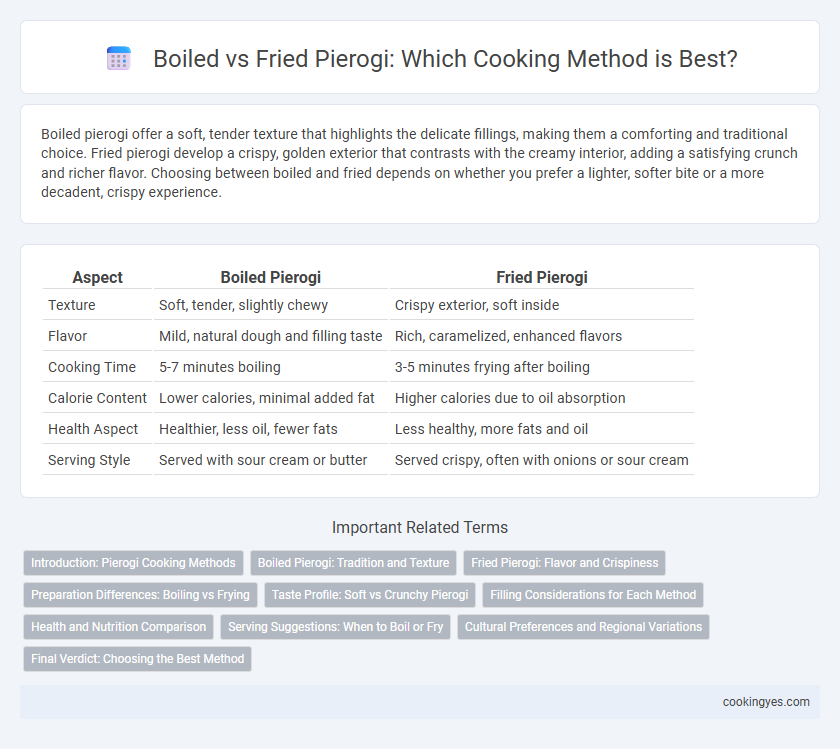Boiled pierogi offer a soft, tender texture that highlights the delicate fillings, making them a comforting and traditional choice. Fried pierogi develop a crispy, golden exterior that contrasts with the creamy interior, adding a satisfying crunch and richer flavor. Choosing between boiled and fried depends on whether you prefer a lighter, softer bite or a more decadent, crispy experience.
Table of Comparison
| Aspect | Boiled Pierogi | Fried Pierogi |
|---|---|---|
| Texture | Soft, tender, slightly chewy | Crispy exterior, soft inside |
| Flavor | Mild, natural dough and filling taste | Rich, caramelized, enhanced flavors |
| Cooking Time | 5-7 minutes boiling | 3-5 minutes frying after boiling |
| Calorie Content | Lower calories, minimal added fat | Higher calories due to oil absorption |
| Health Aspect | Healthier, less oil, fewer fats | Less healthy, more fats and oil |
| Serving Style | Served with sour cream or butter | Served crispy, often with onions or sour cream |
Introduction: Pierogi Cooking Methods
Pierogi are traditionally cooked by boiling, which ensures a tender, moist texture and allows the dough to fully cook through without hardening. Frying pierogi after boiling creates a crispy, golden exterior, adding a desirable contrast to the soft, flavorful filling inside. Choosing between boiled and fried pierogi depends on personal preference and desired texture, with many recipes combining both methods for optimal taste.
Boiled Pierogi: Tradition and Texture
Boiled pierogi retain a soft, tender texture that highlights the traditional Eastern European preparation method. The boiling process preserves the delicate dough and enhances the filling's natural flavors, offering a comforting, authentic bite. This classic technique ensures pierogi remain moist and slightly chewy, distinguishing them from their crispy, fried counterparts.
Fried Pierogi: Flavor and Crispiness
Fried pierogi deliver a rich, golden-brown crust that enhances both flavor and texture, creating a satisfying contrast between the crispy exterior and tender filling. The frying process caramelizes the dough's surface, intensifying savory notes and adding a slight crunch that is absent in boiled versions. This method elevates traditional pierogi, offering a flavor profile that highlights buttery, toasted hints while maintaining the soft interior.
Preparation Differences: Boiling vs Frying
Boiled pierogi are cooked in boiling water until they float to the surface, resulting in a soft, tender texture that highlights the filling's flavor. Fried pierogi, typically pan-fried in oil or butter after boiling, develop a crispy, golden-brown exterior that adds a savory crunch. The choice between boiling and frying affects not only texture but also flavor intensity and preparation time.
Taste Profile: Soft vs Crunchy Pierogi
Boiled pierogi offer a soft, tender texture that highlights the delicate filling, creating a smooth, comforting bite. Fried pierogi develop a golden, crispy exterior that contrasts with the rich, savory inside, providing a satisfying crunch and enhanced flavor depth. Choosing between boiled or fried pierogi ultimately depends on the desired balance of softness versus crispiness in each mouthful.
Filling Considerations for Each Method
Boiled pierogi fillings typically include moist ingredients like mashed potatoes, cheese, or sauerkraut, which soften evenly during cooking without drying out. Fried pierogi fillings benefit from firmer, less watery components such as spiced meat or caramelized onions, ensuring the exterior crisps up while the interior remains intact. Proper filling moisture balance is essential to prevent sogginess in boiled pierogi and bursting during frying.
Health and Nutrition Comparison
Boiled pierogi retain more water-soluble vitamins like vitamin C and B-complex, making them a healthier option with fewer calories and less fat compared to fried versions, which absorb added oils during cooking. Frying pierogi increases their calorie and fat content significantly, potentially impacting cardiovascular health if consumed frequently. Choosing boiled pierogi supports a lower-fat diet while still providing essential nutrients from the dough and filling.
Serving Suggestions: When to Boil or Fry
Boiled pierogi are ideal for a tender, traditional experience often served with sour cream, caramelized onions, or melted butter, enhancing their soft texture. Fried pierogi offer a crispy, golden exterior perfect for appetizers or snacks, frequently accompanied by dipping sauces like sour cream or spicy mustard. Choosing between boiling or frying depends on the desired texture and meal context, such as a comforting main dish or a crunchy hors d'oeuvre.
Cultural Preferences and Regional Variations
Boiled pierogi maintain a soft, tender texture favored in Eastern European countries like Poland and Ukraine, where traditional recipes emphasize simplicity and comfort. Fried pierogi offer a crispy, golden exterior preferred in regions such as the United States and parts of Western Europe, reflecting culinary adaptation and fusion influences. Cultural preferences often dictate preparation methods, with Eastern Slavic cuisines highlighting boiled pierogi served with sour cream, while American adaptations frequently serve fried pierogi with various dipping sauces.
Final Verdict: Choosing the Best Method
Boiled pierogi offer a soft, tender texture that highlights the filling's flavor while maintaining a traditional experience, making them ideal for those who prefer a lighter dish. Fried pierogi provide a crispy, golden exterior that adds a rich, savory contrast to the creamy filling, favored by individuals who enjoy a more indulgent taste and texture. The best method depends on personal preference: boiling emphasizes authenticity and simplicity, while frying enhances texture and flavor complexity.
Boiled vs Fried for Pierogi Infographic

 cookingyes.com
cookingyes.com